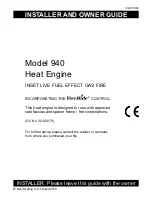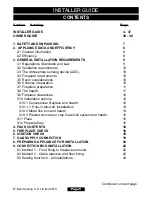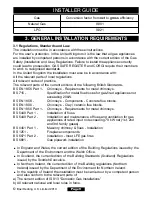
3.6.2
Any chimney damper or restrictor should be removed. If removal is not possible,
they must be secured in the open position.
3.7 Fireplace preparation.
3.7.1
If the fireplace opening is an under floor draught type, it must be sealed to stop
any draughts.
3.7.2
The front face of the fireplace should be reasonably flat over the area covered
by the convection box top and side flange seals to ensure good sealing. These faces
should be made good if necessary. The fireplace floor should be reasonably flat to
ensure that a good seal with the convection box can be made.
3.7.3
If the appliance is to be fitted against
a wall with combustible cladding, the
cladding must be removed from the area
covered by the fascia. The cladding must
also not touch the fascia (See figure 1). We
suggest that the actual fascia is used as a
template to mark the area for combustible
cladding removal and that this area is
increased by at least 2mm all round.
3.7.4
If the fireplace opening is greater
than the acceptable dimensions given in
this guide, do not use the back of a fire
surround or marble to reduce the opening.
This may cause cracking of the surround
back or marble.
3.8 The hearth.
The appliance must be mounted behind a non-combustible hearth unless the
conditions of section 3.10.1.1 are met (N.B. conglomerate marble hearths are
considered as non-combustible). The appliance can be fitted to a purpose made
proprietary class “O”-150°C surround. The hearth material must be at least 12mm
thick. The periphery of the hearth (or fender) should be at least 50mm above floor
level to discourage the placing of carpets or rugs over it.
The surface of the hearth must be sufficiently flat to enable the bottom of the front
surround and the bottom front cover to be aligned horizontally. Any excessive
unevenness (uneven tiles, Cotswold stone, etc.) should be rectified.
The appliance must not stand on combustible materials or carpets
.
Page 11
©
Baxi Heating U.K. Limited 2010.
Figure 1. Removal of combustible
cladding (fascia may differ to that
shown).
INSTALLER GUIDE












































